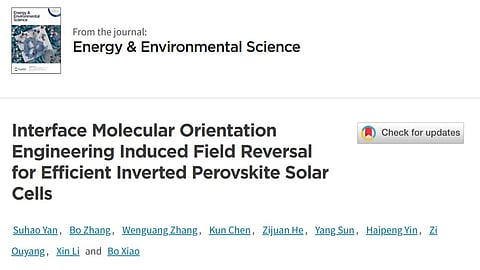

JA Solar has published its research on perovskite tandem solar cell technologies, reporting its progress in the top-tier journal Energy & Environmental Science (EES), under the title Interface Molecular Orientation Engineering Induced Field Reversal for Efficient Inverted Perovskite Solar Cells.
The study focuses on the integration requirements of 2-terminal and 4-terminal tandem PV architectures. By developing a multifunctional diammonium passivation layer (PMEAI) that enables defect passivation, built-in field reversal, and low steric hindrance, the JA Solar R&D team significantly improved device performance and long-term reliability, paving the way for high-efficiency perovskite-silicon tandem integration.
Recently, 2 JA Solar manufacturing sites received SA8000 Social Accountability Management System Certification from TÜV Italia S.R.L. (see China Solar PV News Snippets).
Leading integrated PV manufacturer LONGi plans to acquire a controlling interest in energy storage system (ESS) manufacturer PotisEdge. According to a disclosure by the Shaanxi Administration for Market Regulation, LONGi intends to obtain 61.9998% of voting rights through equity acquisition, capital increase participation, and voting rights entrustment. Upon completion, LONGi will gain sole control of PotisEdge, signaling its strategic expansion into the energy storage manufacturing sector.
Established in 2015, PotisEdge was originally a producer of batteries for electric vehicles. According to its official website, the company entered the energy storage battery business in 2020. It now supplies energy storage solutions for residential, C&I, and utility-scale applications, with an annual production capacity of 31 GWh.
On the PV research side, LONGi recently published 2 major research papers on perovskite tandem and HIBC cell research in Nature (see China Solar PV News Snippets).
China’s National Energy Administration (NEA) has released provincial-level solar PV installation data for Q3 2025. From January to September, newly added grid-connected PV capacity reached 239.53 GW, a slight adjustment from the previously reported 240.27 GW, representing a 48.89% year-over-year (YoY) increase. Centralized PV installations totaled 111.59 GW (+47.49% YoY), while commercial & industrial (C&I) PV added 93.50 GW (+49.79% YoY), and residential PV reached 34.44 GW (+51.04% YoY).
By region, the top 3 provinces for new PV additions during the 9 months were Jiangsu (24.47 GW), Xinjiang (23.28 GW), and Guangdong (17.74 GW).
As of September 2025, China’s cumulative PV capacity reached 1.12 TW, including 616.89 GW of centralized PV, 315.40 GW of C&I rooftop PV, and 192.59 GW of residential PV.
Inner Mongolia has released a comprehensive planning document for ecological security (2025-2035), outlining goals for strengthening ecological protection and advancing green, low-carbon energy development.
The plan calls for accelerating the deployment of distributed PV and decentralized wind, with new PV stations prioritized in border areas, deserts, the Gobi regions, semi-arid landscapes, coal-mining subsidence zones, and waste dump sites of open-pit mines. It also emphasizes the coordinated control of desertification and the development of renewable energy, alongside a large-scale promotion of green hydrogen production.
By 2030, Inner Mongolia aims to exceed 300 GW of new energy installed capacity, with renewable electricity consumption accounting for over 40% of total power usage. According to the regional Energy Administration, as of the end of October this year, the province’s new energy installed capacity totaled 150 GW.
Shaanxi Province has issued several policy documents clarifying the pricing of renewable electricity for projects connected to the grid as of June 1, 2025.
Projects connected before that date will be considered stock projects, with the mechanism electricity prices benchmarked against the current coal-fired tariff at RMB 0.332/kWh. Projects connected after June 1, 2025, and not yet subject to the mechanism tariff, will participate in the electricity market, where prices will be formed competitively; before market participation begins, they will temporarily settle at real-time spot prices.
Shaanxi also released the price bounds for its first competitive mechanism tariff bidding, with a ceiling price of RMB 0.332/kWh and a floor price of RMB 0.2/kWh. The timing and scale of the first bidding round have not yet been announced.
